
- and will tell you all about it when it gets back.
an occasional journal from Somerset, England, about food and cookery


Gosh, quite a lot going on today.
Becks & Posh and Jam Faced are having a historic pudding event today, about English desserts. Not British, or Irish, Welsh or Scottish. Not French. Not Thai.
A bit more of a challenge than I realised actually. Traditional English desserts, well, puds, tend to fall either into the Eccles cake category - dried fruit and pastry - or the stodge and custard category - great if you have to run up and down a hockey pitch or play rugby. Each has its charm but not quite enough of it for me. It was Careme and co who brought light confections of sugar and cream to the English table, but no French puds allowed. Hmmm. What else did we used to eat that I actually loved? Ah ha! FOOL! Gooseberry fool is the best, but rhubarb runs it a close second. And rhubarb is in season. And clotted cream is never out of season. And we have excellent local cider. Hence my dessert for St George, which would not lie heavy on his tummy before he has to go out a-rescuing maidens from dragons.
Clotted Cream Rhubarb Fool with Cider Syrup.

Make a custard with
1/4 pint milk (scalded); mix 1 tsp arrowroot into three egg yolks and add to milk. Bring very slowly back to the boil, stirring constantly, and simmer until thick. Let cool a little and add two big spoonfuls of clotted cream. Mix until smooth.
Cook four sticks of rhubarb with a very little water and sugar to taste until soft but not destroyed. Drain liquid and reserve. Add half of rhubarb to custard.
Dissolve 1 tsp gelatine in reserved rhubarb juice and add to custard mixture. Fill moulds. Chill until set.
Make a syrup with dry cider and demarara sugar. Add to remaining rhubarb.
Any remaining clotted cream can be served on the side.
The colours are lovely on a spring day, pale primrose and rosy pink. The rhubarb has a fresh acidity balanced by the strong apple cider syrup. I think it makes a wonderfully refreshing end to a meal.
 Should I mention that the word 'fool' comes from the French 'fou' or 'folle', as in trifle? Probably best not...
Should I mention that the word 'fool' comes from the French 'fou' or 'folle', as in trifle? Probably best not...

 I'm not posting this because I think anyone wants to know how to roast tomatoes in the oven with garlic and parsley and olive oil, but just to remind them of the fantastic scent that wafts through the house when they are cooking. It winds through all the rooms and drifts past your questing nostrils and makes you remember good meals. Who could not be stirred by that smell? It reminds me of being in France in the middle of a hot July day and sniffing the air as I passed by open windows where lunch was cooking. Hot food on a hot day. Tomatoes and garlic and herbs. Mmmmm.
I'm not posting this because I think anyone wants to know how to roast tomatoes in the oven with garlic and parsley and olive oil, but just to remind them of the fantastic scent that wafts through the house when they are cooking. It winds through all the rooms and drifts past your questing nostrils and makes you remember good meals. Who could not be stirred by that smell? It reminds me of being in France in the middle of a hot July day and sniffing the air as I passed by open windows where lunch was cooking. Hot food on a hot day. Tomatoes and garlic and herbs. Mmmmm.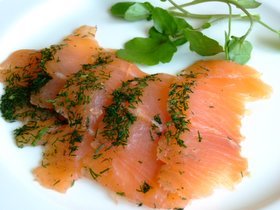
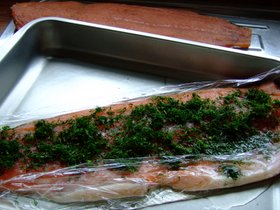


Once you have your salmon fillets you have to remove the pinbones. You really need tweezers for this and it is indeed one of those culinary labours of love. You know that if you don’t do your best your daughter will be the one that gets the bones – she always gets the bones, or the shot, or, with a bit of luck, the sixpence in the Christmas Pudding.
If you feel along between the backbone and the edge of the fillet, on the thick side, your fingers will find the little sharp bones and you can pull them out with the tweezers.
Ingredients:
2 salmon fillets
100g salt
3 tbsp sugar
1 tbsp white pepper
4 tsp allspice
4 tbsp vodka (or brandy, or gin)
2 bunches dill - chopped
Method:
Take out the pinbones from the salmon as above. Mix all the other ingredients except the dill.
Strew the base of a glass or ceramic dish with dill, lay the first fillet on top and rub well with the brine mixture. Strew more dill on top and repeat process with second fillet, laying it on top of the first in the opposite direction. Scatter remaining dill over all.
Cover everything with plastic wrap, not aluminium foil, put a board on top and weight down. Refrigerate for two or three days, turning regularly and basting with the brine. Taste at end of second day and if the fish is bland increase the salt/vodka.
Finally, pour off the brine and either use the cured salmon or refrigerate until needed – the fish will keep for a week in the refrigerator.
You could serve this with dill mustard sauce, but I was thinking wasabi.
I’ll let you know how it comes along.
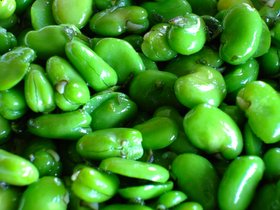
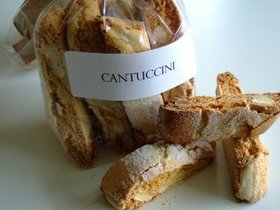
 I have a very good friend that I don’t get to see very much, because he lives at the other end of the country. We chat on the phone about food and life. He has an allotment – I would love to have an allotment, but my Parish Council doesn’t own any. (Apparently there’s a very old law that states that if 6 people want allotments the council has to provide them, so I’m working on it.)
I have a very good friend that I don’t get to see very much, because he lives at the other end of the country. We chat on the phone about food and life. He has an allotment – I would love to have an allotment, but my Parish Council doesn’t own any. (Apparently there’s a very old law that states that if 6 people want allotments the council has to provide them, so I’m working on it.)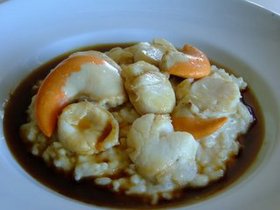
 Lindy, who lives in Pittsburgh, has a blog called Toast, and when she was in Somerset last year she noticed this 'intriguing cookshop' which was unfortunately closed. Well today it was open
Lindy, who lives in Pittsburgh, has a blog called Toast, and when she was in Somerset last year she noticed this 'intriguing cookshop' which was unfortunately closed. Well today it was open  (actually it's very rarely closed) and its manager, Sally, is sorry she missed you Lindy! Kitchenmonger is at 17 Market Place, Wells, Somerset, or telephone +44 1749 676044. And they have everything.
(actually it's very rarely closed) and its manager, Sally, is sorry she missed you Lindy! Kitchenmonger is at 17 Market Place, Wells, Somerset, or telephone +44 1749 676044. And they have everything.

 Blue Box. I found these excellent storage jars and some really good value zipped hanging bags for clothes. But I digress.)
Blue Box. I found these excellent storage jars and some really good value zipped hanging bags for clothes. But I digress.)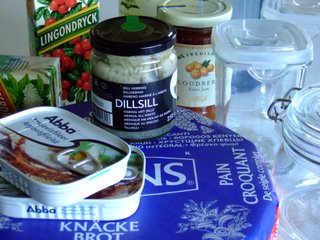 I also bought: Cloudberry jam, rye crispbread (loved the packaging), tinned anchovies, elderflower drink, lingonberry drink, elderflower cordial, oh and a bottle of swedish vodka (to put the elderflower cordial in, apparently).
I also bought: Cloudberry jam, rye crispbread (loved the packaging), tinned anchovies, elderflower drink, lingonberry drink, elderflower cordial, oh and a bottle of swedish vodka (to put the elderflower cordial in, apparently).
 Then the sun came out and, overnight it seemed, the world turned yellow. The daffodils that had been lurking in the hedgerows gathered confidence and burst into bloom, white narcissi with orange eyes nod in the borders, huge yellow tulips with black centres, and the primroses - ahhh, my favourites.
Then the sun came out and, overnight it seemed, the world turned yellow. The daffodils that had been lurking in the hedgerows gathered confidence and burst into bloom, white narcissi with orange eyes nod in the borders, huge yellow tulips with black centres, and the primroses - ahhh, my favourites. was going to buy some from an expensive shop, but it looked terribly anaemic and I thought it can't be that difficult. It isn't. Why have I never done this before? This recipe makes two jars of curd - which is quite enough as it has to live in the fridge and won't last forever - and when you open the fridge door the blast of colour almost hurts your eyes.
was going to buy some from an expensive shop, but it looked terribly anaemic and I thought it can't be that difficult. It isn't. Why have I never done this before? This recipe makes two jars of curd - which is quite enough as it has to live in the fridge and won't last forever - and when you open the fridge door the blast of colour almost hurts your eyes. 
 Yesterday I wrote about the little city of Wells and its bustling market. I should also mention that it has a quantity of great charity shops. In one of these I found a potato ricer. An Austrian lady beside me said "Excellent buy - they make vunderful potato cakes".
Yesterday I wrote about the little city of Wells and its bustling market. I should also mention that it has a quantity of great charity shops. In one of these I found a potato ricer. An Austrian lady beside me said "Excellent buy - they make vunderful potato cakes".
 Mix the butter into the potatoes with the salt. Work in the flour quickly but thoroughly and knead lightly. Divide in two and roll out each half on a floured board to form a circle about the size of a large dinner plate. Cut in quarters (farls) and cook for about 3 minutes on each side on a griddle or in a heavy frying pan in a little bacon fat.
Mix the butter into the potatoes with the salt. Work in the flour quickly but thoroughly and knead lightly. Divide in two and roll out each half on a floured board to form a circle about the size of a large dinner plate. Cut in quarters (farls) and cook for about 3 minutes on each side on a griddle or in a heavy frying pan in a little bacon fat. 
 Wells Market on a Saturday positively buzzes. Wells is technically a city because it has a cathedral, but it is more like a town on account of its tiny size. In these dark rainswept winter days the vegetable choice is confined to roots, which I do like,
Wells Market on a Saturday positively buzzes. Wells is technically a city because it has a cathedral, but it is more like a town on account of its tiny size. In these dark rainswept winter days the vegetable choice is confined to roots, which I do like,  But before I made it to the vegetables I lingered at the stall of Bruno, from Préaux in France, who sells cheese and paté and the most unctuous goose rillettes.
But before I made it to the vegetables I lingered at the stall of Bruno, from Préaux in France, who sells cheese and paté and the most unctuous goose rillettes. Then on to the beetroot, and fresh flat leaf parsley, and a big bunch of daffodils for the study window. After lunch (rillettes and toast - the toast made from the billowing dough from yesterday which amazingly made the best loaf ever) I turned the oven up high, chopped all but a tuft off the beetroot, put them in a dish with a little water and covered the dish with tinfoil. Into the oven for an hour while I write this.
Then on to the beetroot, and fresh flat leaf parsley, and a big bunch of daffodils for the study window. After lunch (rillettes and toast - the toast made from the billowing dough from yesterday which amazingly made the best loaf ever) I turned the oven up high, chopped all but a tuft off the beetroot, put them in a dish with a little water and covered the dish with tinfoil. Into the oven for an hour while I write this. over some red wine or balsamic vinegar, maybe a little olive oil and herbs, perhaps some pine nuts, and serve with wild rocket and goats cheese. The little ruby baby beets are sweet and almost crunchy, the white goats cheese is tart and creamy, it's a lovely supper dish or a starter to give the appetite an edge.
over some red wine or balsamic vinegar, maybe a little olive oil and herbs, perhaps some pine nuts, and serve with wild rocket and goats cheese. The little ruby baby beets are sweet and almost crunchy, the white goats cheese is tart and creamy, it's a lovely supper dish or a starter to give the appetite an edge.
